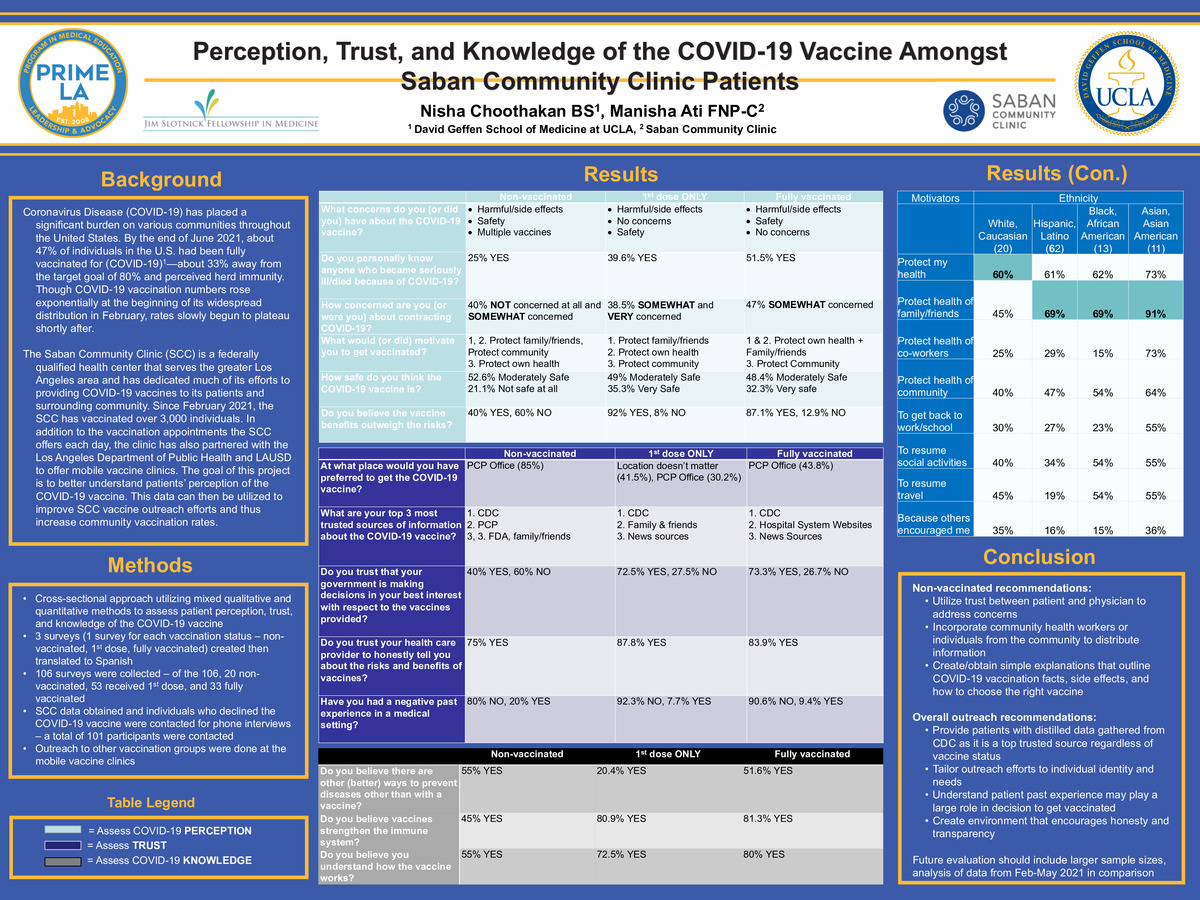-
Author
Nisha Choothakan -
PI
Manisha Ati, FNP-C
-
Co-Author
N/A
-
Title
Perception, Trust, and Knowledge of the COVID-19 Vaccine Amongst Saban Community Clinic Patients
-
Program
Other
-
Other Program (if not listed above)
Jim Slotnick Fellowship in Medicine
-
Abstract
Background
Coronavirus Disease (COVID-19) has placed a significant burden on various communities throughout the United States. By the end of June 2021, about 47% of individuals in the U.S. had been fully vaccinated for (COVID-19)—about 33% away from the target goal of 80% and perceived herd immunity. Though COVID-19 vaccination numbers rose exponentially at the beginning of its widespread distribution in February, rates slowly begun to plateau shortly after.
The Saban Community Clinic (SCC) is a federally qualified health center that serves the greater Los Angeles area and has dedicated much of its efforts to providing COVID-19 vaccines to its patients and surrounding community. Since February 2021, the SCC has vaccinated over 3,000 individuals. In addition to the vaccination appointments the SCC offers each day, the clinic has also partnered with the Los Angeles Department of Public Health and LAUSD to offer mobile vaccine clinics. The goal of this project is to better understand patients’ perception of the COVID-19 vaccine. This data can then be utilized to improve SCC vaccine outreach efforts and thus increase community vaccination rates.
Objectives
- To understand COVID-19 vaccine perception
- To understand perceived barriers to COVID-19 vaccination
- To create innovative solutions to achieve herd immunity
Methods
This study employs a cross-sectional approach that utilizes mixed quantitative and qualitative methods to assess patient trust, perception, and knowledge of the COVID-19 vaccine. Three separate surveys were created utilizing relevant questions obtained from the WHO and CDC and were made available in two languages: English and Spanish. Each survey corresponded to the individual’s vaccination status (non-vaccinated, received 1st dose, fully vaccinated). A total of 106 surveys were collected. Of the 106, 20 corresponded to non-vaccinated individuals, 53 receiving 1st dose, and 33 fully vaccinated. SCC data regarding patients who declined the COVID-19 vaccine, from May to June, was obtained and a total of 101 individuals were contacted for phone interviews. Outreach to about 120 individuals, who had only received their first dose and/or to those fully vaccinated, was performed at the mobile vaccine clinics hosted by SCC.
Results
Perception, trust, and knowledge were assessed utilizing various subsets of questions. When understanding patient perception of COVID-19 and the vaccine, non-vaccinated individuals tended to have more concerns regarding safety and side effects and were less likely to know someone (family, friend, or community member) who had been seriously affected by COVID-19. Moreover, non-vaccinated individuals were more likely to be “not concerned at all” about contracting COVID-19 when compared to both 1st dose only and fully vaccinated individuals. When assessing trust, regardless of vaccination status, all groups preferred getting vaccinated at their primary care provider’s (PCP) office and reported strong levels of trust with their PCP. However, levels of mistrust in the government increased from fully vaccinated individuals to non-vaccinated individuals. When assessing knowledge, 55% of non-vaccinated individuals reported understanding of how the COVID-19 vaccine worked whereas those with their 1st dose only and fully vaccinated individuals reported 72.5% and 80% of understanding, respectively. Lastly, the data was further broken down to understand possible trends between ethnicity and top motivations to get vaccinated.
Conclusion:
- Since there seems to be a strong level of trust between the patient and PCP, mobilize healthcare providers to aid in addressing concerns of patients who are currently not vaccinated.
- Utilize community health workers or individuals from certain communities as a way to distribute information about the vaccine within their respective communities.
- Obtain and distribute simple explanations from the CDC that outline how the COVID-19 vaccine works, possible side effects, and how to choose the “right” vaccine for you.
- Tailor outreach efforts according to individual needs.
References:
- U.S. COVID-19 vaccine Tracker: See your state’s progress (2019). MayoClinic. Retrieved from: https://www.mayoclinic.org/coronavirus-covid-19/vaccine-tracker
- The Determinants of Vaccine Hesitancy (2021). World Health Organization (WHO). Retrieved from: https://www.who.int/immunization/sage/meetings/2013/april/4_survey_questionsRevised.pdf
- COVID-19 Vaccine Confidence: Rapid Community AssessmentTool (2021). Center for Disease Control and Prevention (CDC). Retrieved from: https://www.cdc.gov/vaccines/covid-19/vaccinate-with-confidence/rca-guide/downloads/CDC_RCA_Guide_2021_Tools_AppendixD_Surveys-508.pdf
-
PDF
-
Zoom

